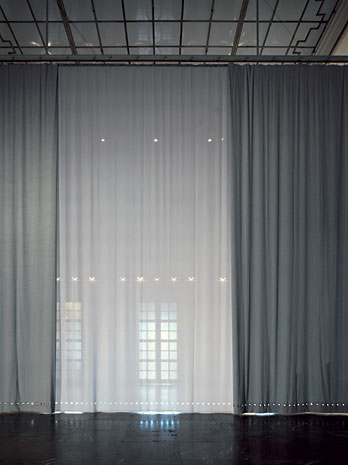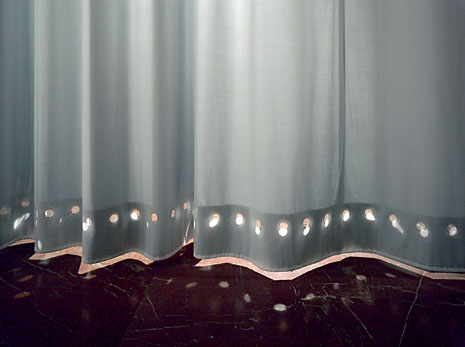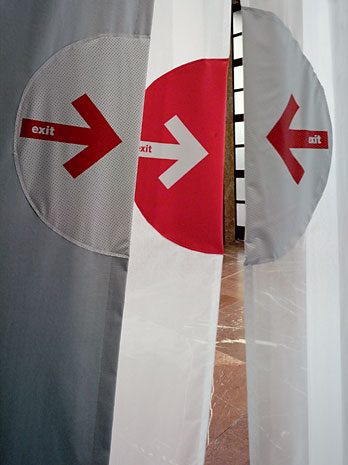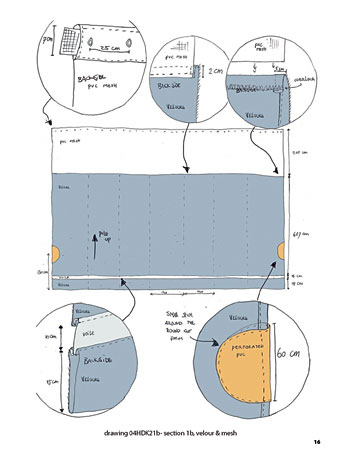The architect Ludwig Wittgenstein
would never have had any work for
someone like Petra Blaisse, an
enthusiastic designer and champion of
decorative additions and interventions.
However, the pronouncement of
Ludwig Wittgenstein the philosopher –
“Die Welt ist alles, was der Fall ist”
(“The world is everything, which is the
case”) – perfectly describes Petra
Blaisse’s career and in particular her
working methods and wide-ranging
oeuvre.
For example, when she deliberately
contradicts the instrumental rationality
of architectural design by introducing
generous curves, circles or ovals. This
is how Blaisse creates space for
“otherness”: there is no longer any fear
of the exotic or the sophisticated.
On the contrary, Blaisse's interventions
add a “primary image” to the building,
an additional, diffuse transparency.
Indeed, the fact that one does not
preclude the other – whether actual or
metaphorical transparency – is
demonstrated by the results of the
frequent architectural collaborations
between Blaisse and Rem Koolhaas.
In The Fold: Leibniz and the Baroque
(Le Pli: Leibniz et le baroque, Editions
de Minuit, Paris 1988), Deleuze tells us
that what is folded is the enclosed, and
that what is folded only exists in an
envelope, in what it envelops: “A fold is
always folded within a fold, like a
cavern in a cavern.” For Petra Blaisse,
all of this, from folds to knots, is
acceptable and normal because, to
return to Wittgenstein: “Die Welt ist
alles, was der Fall ist.” The architect Ludwig Wittgenstein
would never have had any work for
someone like Petra Blaisse, an
enthusiastic designer and champion of
decorative additions and interventions.
However, the pronouncement of
Ludwig Wittgenstein the philosopher –
“Die Welt ist alles, was der Fall ist”
(“The world is everything, which is the
case”) – perfectly describes Petra
Blaisse’s career and in particular her
working methods and wide-ranging
oeuvre.
For example, when she deliberately
contradicts the instrumental rationality
of architectural design by introducing
generous curves, circles or ovals. This
is how Blaisse creates space for
“otherness”: there is no longer any fear
of the exotic or the sophisticated.
On the contrary, Blaisse's interventions
add a “primary image” to the building,
an additional, diffuse transparency.
Indeed, the fact that one does not
preclude the other – whether actual or
metaphorical transparency – is
demonstrated by the results of the
frequent architectural collaborations
between Blaisse and Rem Koolhaas.
In The Fold: Leibniz and the Baroque
(Le Pli: Leibniz et le baroque, Editions
de Minuit, Paris 1988), Deleuze tells us
that what is folded is the enclosed, and
that what is folded only exists in an
envelope, in what it envelops: “A fold is
always folded within a fold, like a
cavern in a cavern.” For Petra Blaisse,
all of this, from folds to knots, is
acceptable and normal because, to
return to Wittgenstein: “Die Welt ist
alles, was der Fall ist.”

Tropical Boho Homes With Beautiful Vignettes & Vistas
Two tropical boho home designs, featuring swimming pools, cozy lighting schemes, interior archways, natural accents, and beautiful decor vignettes.






![A Tranquil Jungle House That Incorporates Japanese Ethos [Video]](https://asean2.ainewslabs.com/images/22/08/b-2ennetkmmnn_t.jpg)









